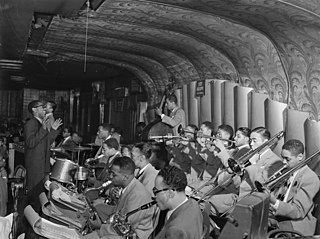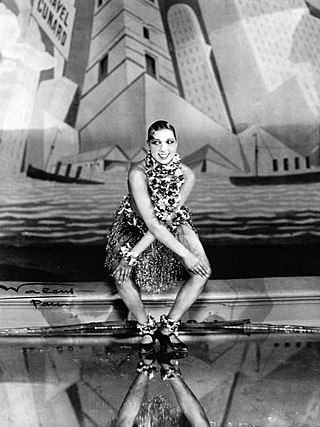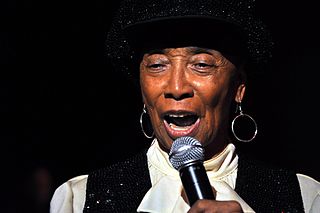Related Research Articles

East Coast Swing (ECS) is a form of social partner dance. It belongs to the group of swing dances. It is danced under fast swing music, including: big band, rock and roll, rockabilly, and boogie-woogie.

The Savoy Ballroom was a large ballroom for music and public dancing located at 596 Lenox Avenue, between 140th and 141st Streets in the Harlem neighborhood of Manhattan, New York City. Lenox Avenue was the main thoroughfare through upper Harlem. Poet Langston Hughes calls it the "Heartbeat of Harlem" in Juke Box Love Song, and he set his work "Lenox Avenue: Midnight" on the legendary street. The Savoy was one of many Harlem hot spots along Lenox, but it was the one to be called the "World's Finest Ballroom". It was in operation from March 12, 1926, to July 10, 1958, and as Barbara Englebrecht writes in her article "Swinging at the Savoy", it was "a building, a geographic place, a ballroom, and the 'soul' of a neighborhood". It was opened and owned by white entrepreneur Jay Faggen and Jewish businessman Moe Gale. It was managed by African-American businessman and civic leader Charles Buchanan. Buchanan, who was born in the British West Indies, sought to run a "luxury ballroom to accommodate the many thousands who wished to dance in an atmosphere of tasteful refinement, rather than in the small stuffy halls and the foul smelling, smoke laden cellar nightclubs ..."

The Charleston is a dance named after the harbor city of Charleston, South Carolina. The rhythm was popularized in mainstream dance music in the United States by a 1923 tune called "The Charleston" by composer/pianist James P. Johnson, which originated in the Broadway show Runnin' Wild and became one of the most popular hits of the decade. Runnin' Wild ran from 28 October 1923 through 28 June 1924. The Charleston dance's peak popularity occurred from mid-1926 to 1927.
An Aerial is a dance move in Lindy Hop or Boogie Woogie where one's feet leave the floor. As opposed to a lift, aerial is a step where a partner needs to be thrown into the air and then landed in time with the music. Each aerial consists of a preparation ('prep'), jump or trick itself and the landing.

Swing dance is a group of social dances that developed with the swing style of jazz music in the 1920s–1940s, with the origins of each dance predating the popular "swing era". Hundreds of styles of swing dancing were developed; those that have survived beyond that era include Charleston, Balboa, Lindy Hop, and Collegiate Shag. Today, the best-known of these dances is the Lindy Hop, which originated in Harlem in the early 1930s. While the majority of swing dances began in African-American communities as vernacular African-American dances, some influenced swing-era dances, like Balboa, developed outside of these communities.
The Suzie Q is a dance step in the Big Apple, Lindy Hop, Salsa, and other dances. In line dances this step is also known as heel twist or grind walk. The step is also used in jazz dance, and in Salsa shines.
Some films feature recognizable dance forms, demonstrating them, shedding light on their origin, or being the base of a plot.

Frank Manning was an American dancer, instructor, and choreographer. Manning is considered one of the founders of Lindy Hop, an energetic form of the jazz dance style known as swing.

The Tranky Doo is a jazz dance choreography.
Whitey's Lindy Hoppers was a professional performing group of exceptional swing dancers that was first organized in the late 1920s by Herbert "Whitey" White in the Savoy Ballroom and disbanded in 1942 after its male members were drafted into World War II. The group took on many different forms and had several different names and sub-groups, including Whitey's Hopping Maniacs, Harlem Congeroo Dancers, and The Hot Chocolates. In addition to touring nationally and internationally, the group appeared in several films and Broadway theatre productions. Dorothy Dandridge and Sammy Davis Jr. were among the group's celebrity regulars.
Al Minns, was a prominent American Lindy Hop and jazz dancer. Most famous for his film and stage performances in the 1930s and 1940s with the Harlem-based Whitey's Lindy Hoppers, Minns worked throughout his life to promote the dances that he and his cohorts helped to pioneer at New York's Savoy Ballroom. In 1938, Al Minns and Sandra Gibson won the Harvest Moon Ball.
Locking is a style of funk dance, which is today also associated with hip hop. The name is based on the concept of locking movements, which means freezing from a fast movement and "locking" in a certain position, holding that position for a short while and then continuing at the same speed as before. It relies on fast and distinct arm and hand movements combined with more relaxed hips and legs. The movements are generally large and exaggerated, and often very rhythmic and tightly synced with the music. Locking is performance oriented, often interacting with the audience by smiling or giving them a high five, and some moves are quite comical.

The history of Lindy Hop begins in the African American communities of Harlem, New York during the late 1920s in conjunction with swing jazz. Lindy Hop is closely related to earlier African American vernacular dances but quickly gained its own fame through dancers in films, performances, competitions, and professional dance troupes. It became especially popular in the 1930s with the upsurge of aerials. The popularity of Lindy Hop declined after World War II, and it converted to other forms of dancing, but it never disappeared during the decades between the 1940s and the 1980s until European and American dancers revived it starting from the beginning of the 1980s.

Norma Adele Miller was an American Lindy hop dancer, choreographer, actress, author, and comedian known as the "Queen of Swing".
Dajchovo horo is a Bulgarian folk dance done to a nine-beat meter. It is unique in two ways: it is a circle dance, and yet it has a leader.
"Jumpin' at the Woodside" is a song first recorded in 1938 by the Count Basie Orchestra, and considered one of the band's signature tunes. When first released it reached number 11 on the Billboard charts and remained on them for four weeks. Since then, it has become a frequently recorded jazz standard.

The Lindy Hop is an American dance which was born in the African-American communities of Harlem, New York City, in 1928 and has evolved since then. It was very popular during the swing era of the late 1930s and early 1940s. Lindy is a fusion of many dances that preceded it or were popular during its development but is mainly based on jazz, tap, breakaway, and Charleston. It is frequently described as a jazz dance and is a member of the swing dance family.
The Collegiate Shag is a partner dance done primarily to uptempo swing and pre-swing jazz music. It belongs to the swing family of American vernacular dances that arose in the 1920s and 30s. It is believed that the dance originated within the African American community of the Carolinas in the 1920s, later spreading across the United States during the 1930s. The shag is still danced today by swing dance enthusiasts worldwide.
Leon James was a prominent American Lindy Hop and jazz dancer. A performer during the 1930s and 1940s with the Harlem-based Whitey's Lindy Hoppers, he and his dance partner Willa Mae Ricker were featured in a photo essay in the August 23, 1943, issue of Life magazine, demonstrating air steps.
References
- Arthur Murray.com, History, archived from the original on 11 October 2007, retrieved 2007-11-04
- Guest, Dan, Big Apple History, archived from the original on 1 November 2007, retrieved 2007-11-04, used with the author's permission
- Hazzard-Gordon, Katrina (1990), Jookin': the rise of social dance formations in African-American culture, Philadelphia: Temple University Press, ISBN 0-87722-956-2
- Jitterbuzz, Interview With Betty Wood , retrieved 2007-11-04
- Manning, Frankie; Millman, Cynthia R. (2007), Frankie Manning: Ambassador of Lindy Hop, Philadelphia: Temple University Press, ISBN 1-59213-563-3
- Wilkinson, Jeff (2003-08-24), "'The music would just take you'", The State , archived from the original on 2004-04-30, retrieved 2007-11-06
- Wilkinson, Jeff (2003-08-25), "'You just got in a group and followed along'", The State , archived from the original on 2004-01-06, retrieved 2007-11-04
- Wilkinson, Jeff (2003-08-26), "'The South Carolina dance was social. It didn't have the flash.'", The State , archived from the original on 2003-09-03, retrieved 2007-11-04
- Wilkinson, Jeff (2003-08-27), "'It helps identify and define our culture'", The State , archived from the original on 2004-01-12, retrieved 2007-11-06
- 'Learn to Dance the Big Apple', 2008